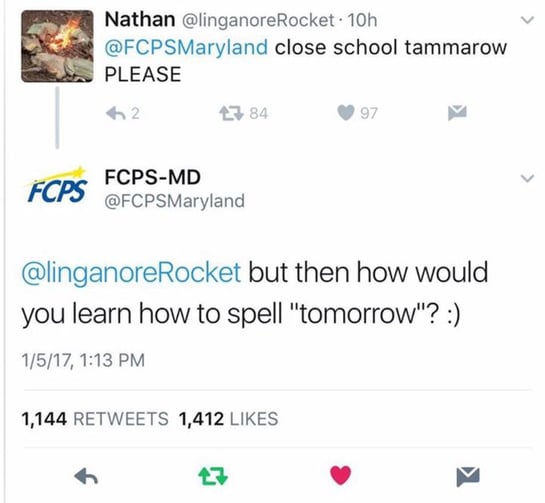Children are often asked, "What do you want to be when you grow up?" What if I told you that your dream can come true or be stripped away in 140 characters or less?
Yes, a tweet can yield the power to not only help you become President of the United States, but it can also find you being told, "You're fired."
Frederick County Public Schools recently fired web experience coordinator Katie Nash from her position for correcting a student's spelling of the word "tomorrow" (tweeted "tammarow" by the student) via tweet on January 5, 2017.
Hired to engage with FCPS attendees of all ages in their preferred world of hashtags, likes, and snaps, Nash's mission was to be more interactive with students on social media. Without interactivity, or engagement, social media is truly nothing more than a shouting contest with every megaphone for him/herself. Social media is successful only when engagement occurs. In fact, the student who originally tweeted FCPS continued the conversation and stated that he wasn't offended by the spelling lesson.

So why would a tweet correcting the misspelling of the word "tomorrow" cause so much harm?
While Nash stated that she didn't “...want to be a distraction to the school system and the goals they have for overarching achievement,” one must ask, how is using social media as a teaching tool a distraction from that goal of achievement?
Leveraging social media to engage with a student in a positive way and providing a learning lesson at the same time appears to be fulfilling that mission.
There are some that point out that this interaction took place in public, not in the protection of the classroom. Others have commented that it wasn't Nash's place to correct the student, that a teacher is the right person for these situations. In other instances, one might agree with these points of view, if the lesson in question was more technical or sensitive in nature.
I feel that spelling falls under the category of life lessons associated with tying one's shoes and how to tell time.
So how do we navigate the treacherous waters of social media across generations, organizations, countries, and religions? One tweet at a time.
Start With A Social Media Policy
Reports and FCPS's website do not reference a social media policy, the cornerstone to any organization's social media communications strategy. In the case of public organizations, it's highly encouraged to publish a social media policy online.
These policies effectively define the parameters of the social media sandbox. A social media policy governance document should define what information can be posted, what type of engagement to expect, and what is appropriate for social media posting. It takes the guesswork out of social media and sets clear expectations for rules of engagement.
"Students have been tweeting at us, but I wasn’t really sure what I should be doing or not doing. I sort of assumed there would be a follow-up conversation," Nash stated in an interview. A social media policy would've helped alleviate the confusion in this particular case.
Social media policies are not just about policing what can and cannot be said on social media. These policies also can encourage individuals within the organization to embrace and leverage social media as a tool for increasing engagement with the people they serve.
Imagine an education system that embraces social media as a teaching tool. According to BBC, distance learning models that employ social media have shown promising results when compared to classroom only environments. Distance learning classes utilizing social media tools indicate that student participation is greatly increased when social media platforms are integrated with the coursework. Some research shows that distance learning also reduces drop-out rates.
Engagement in Education
Nash reported that Frederick County Public School's goal, which emerged from focus group research, was to increase engagement after receiving feedback that "our tweeting was a bit flat." On the right track, Nash decided to increase engagement by interacting with students.
In fact, social media's parents are from none other than one of the most prestigious schools in the United States: Harvard University. Since it was first imagined ten years ago, social media has transformed the way people interact with one another both in and out of the classroom.
Social media engagement goes beyond posting content. Engagement is the art of the online conversation. It's a tangible, long-term relationship between two people, an organization, and an individual or even two organizations. This open line of communication is just like any other relationship. It's built on trust earned over time through a series of conversations.
Not engaging in two-way communication created by social media breaks down trust. In this case, the trust relationship between FCPS and their students has been tested.
Using Social Listening
Organizations that invest in social listening are paid back their investment in spades. Faster than a Bye-Bye Birdie telephone line, social listening can give organizations insight that can be leveraged for product/service development, customer service, marketing, and sales. Social listening is an active practice, often confused with social monitoring. Listening requires the practitioner to look at interactions with the brand on social media in context and distill meaning that's actionable and useful to the organization.
If FCPS is engaged in social listening, they're certainly getting a robust inbox of feedback to analyze. It's important now that FCPS leverages social listening to learn from their current Twitter mishap.
Organizations that engage in social listening can leverage these digital platforms to speed up or influence product/service development instead of waiting for planned focus groups. Customer service professionals can use social listening to judge the success of their front-line customer service teams and digital help tools. Marketing professionals can leverage social listening to analyze for triggers related to the company’s buyer journey. These triggers make excellent content, campaign themes, and helpful customer FAQs.
FCPS can leverage social listening not only for the current situation but also for improvements to their services. FCPS can employ social listening to gauge the success of its communication programs with multiple audiences, including students, faculty, parents, and the greater community.
Social listening can be used to gather feedback about the timeliness of school communications and classroom learning techniques as well as look for opportunities to rally the community around our school system and the success of students.
When The Student Is Ready, The Teacher Will Appear
In marketing, we learn that in order to be successful, we must speak the language of the customer. Confusion in the conversation between the organization and the individual leads to costly friction.
The same is true for education. As adults, we are all role models and educators alike. It is our responsibility to teach by example and in ways that embrace our student's strengths. If our students' succeed via social media, it's our duty to incorporate this valuable tool into our workbench and use it to communicate with them, to teach them, and to engage them.
I applaud Katie Nash for taking a seemingly small but brave step toward more meaningful social media engagement between FCPS and its students. After all, learning life lessons cannot always wait for tammarow.
If you feel your business needs to assess its social media platform with content, channels, and/or policies, reach out to us. We'd be happy to take a look and offer our recommendations.

